An Analysis of Learning Theory for Educators: Application & Assessment
VerifiedAdded on 2020/05/16
|10
|1556
|33
Essay
AI Summary
This essay provides an overview of various learning theories relevant to educators, including portfolio assessment, multiple intelligence approach, Wechsler Scale, Triarchic Theory, Stanford Binet Test, and Vineland Adaptive Behaviour Scale. It further discusses behaviorism, Piaget's cognitive development theory, and socio-cultural theory, comparing their similarities and differences. The essay emphasizes the importance of socio-cultural theory in early childhood education, highlighting the role of culture and the zone of proximal development in shaping cognitive functions. It concludes that understanding these theories is crucial for educators to effectively support children's learning and development. Desklib is a platform where you can find similar solved assignments.
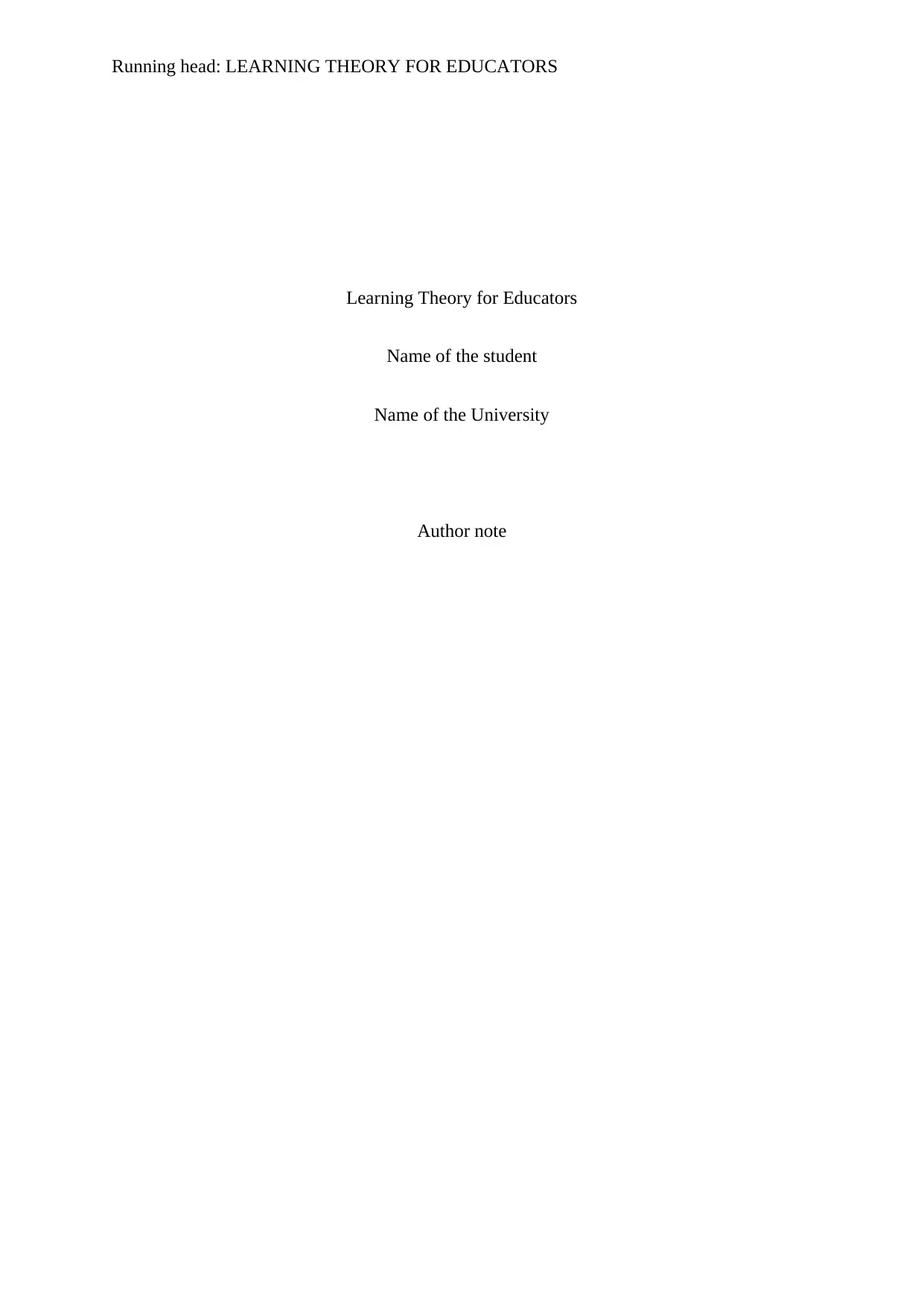
Running head: LEARNING THEORY FOR EDUCATORS
Learning Theory for Educators
Name of the student
Name of the University
Author note
Learning Theory for Educators
Name of the student
Name of the University
Author note
Paraphrase This Document
Need a fresh take? Get an instant paraphrase of this document with our AI Paraphraser
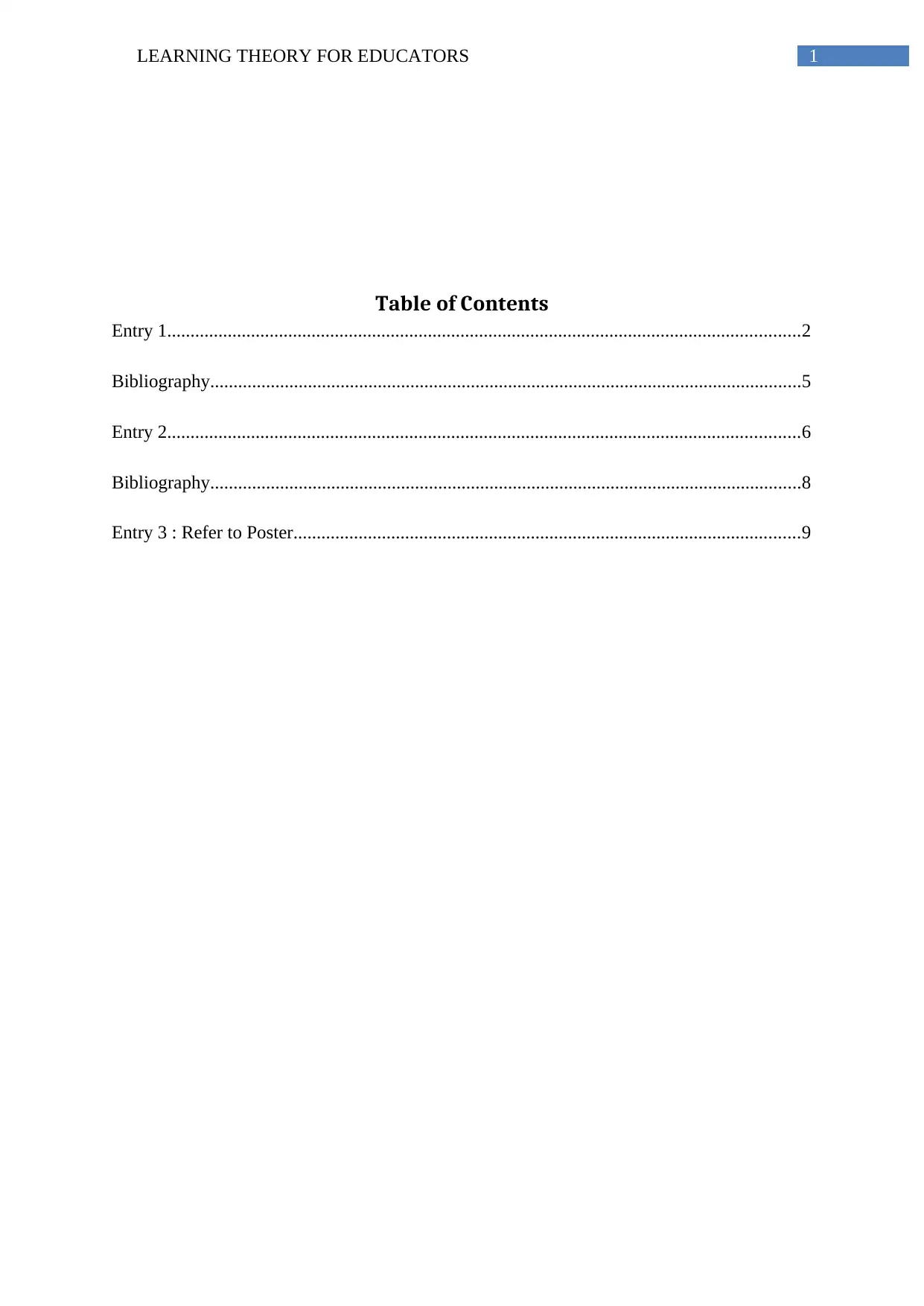
1LEARNING THEORY FOR EDUCATORS
Table of Contents
Entry 1........................................................................................................................................2
Bibliography...............................................................................................................................5
Entry 2........................................................................................................................................6
Bibliography...............................................................................................................................8
Entry 3 : Refer to Poster.............................................................................................................9
Table of Contents
Entry 1........................................................................................................................................2
Bibliography...............................................................................................................................5
Entry 2........................................................................................................................................6
Bibliography...............................................................................................................................8
Entry 3 : Refer to Poster.............................................................................................................9
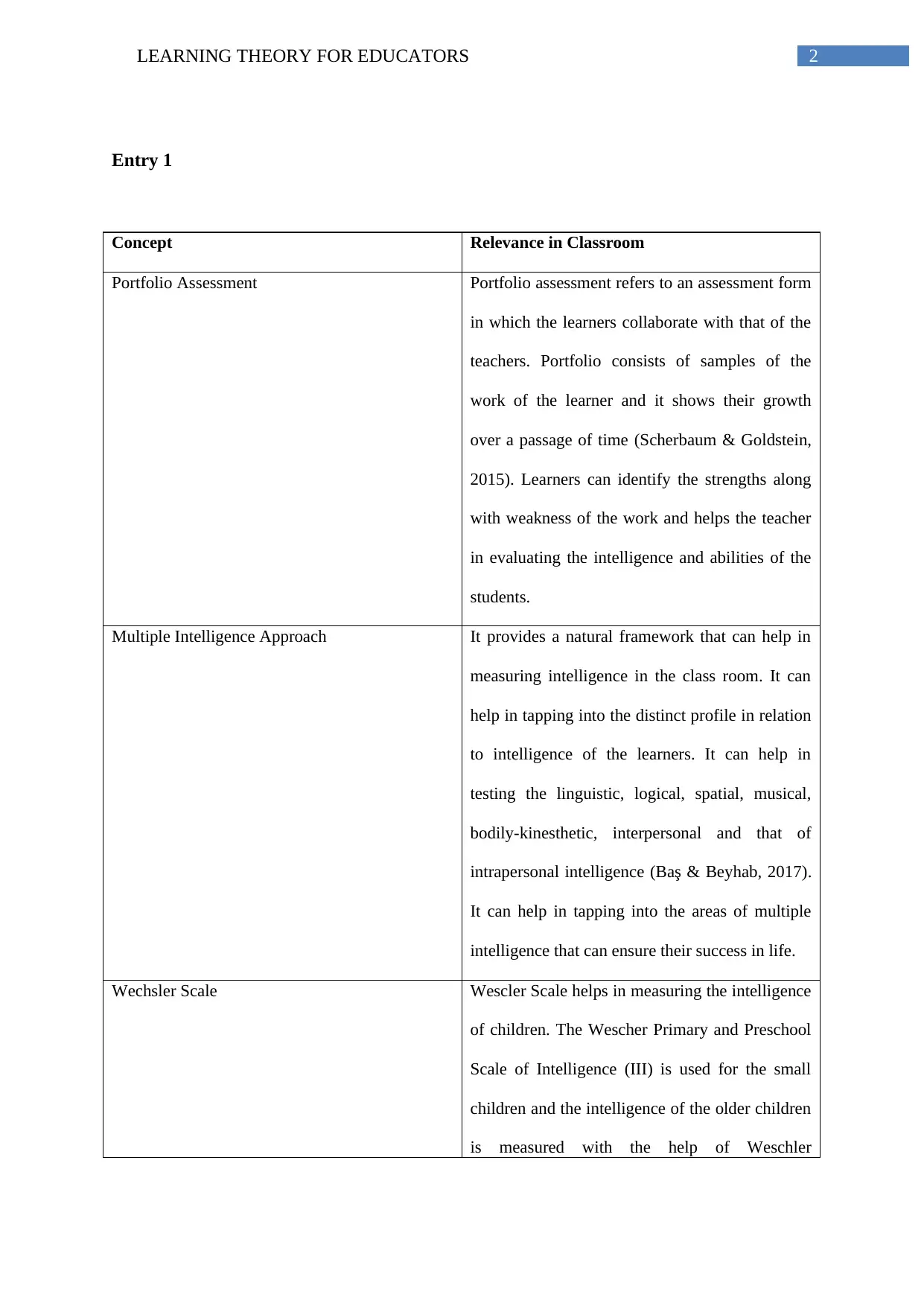
2LEARNING THEORY FOR EDUCATORS
Entry 1
Concept Relevance in Classroom
Portfolio Assessment Portfolio assessment refers to an assessment form
in which the learners collaborate with that of the
teachers. Portfolio consists of samples of the
work of the learner and it shows their growth
over a passage of time (Scherbaum & Goldstein,
2015). Learners can identify the strengths along
with weakness of the work and helps the teacher
in evaluating the intelligence and abilities of the
students.
Multiple Intelligence Approach It provides a natural framework that can help in
measuring intelligence in the class room. It can
help in tapping into the distinct profile in relation
to intelligence of the learners. It can help in
testing the linguistic, logical, spatial, musical,
bodily-kinesthetic, interpersonal and that of
intrapersonal intelligence (Baş & Beyhab, 2017).
It can help in tapping into the areas of multiple
intelligence that can ensure their success in life.
Wechsler Scale Wescler Scale helps in measuring the intelligence
of children. The Wescher Primary and Preschool
Scale of Intelligence (III) is used for the small
children and the intelligence of the older children
is measured with the help of Weschler
Entry 1
Concept Relevance in Classroom
Portfolio Assessment Portfolio assessment refers to an assessment form
in which the learners collaborate with that of the
teachers. Portfolio consists of samples of the
work of the learner and it shows their growth
over a passage of time (Scherbaum & Goldstein,
2015). Learners can identify the strengths along
with weakness of the work and helps the teacher
in evaluating the intelligence and abilities of the
students.
Multiple Intelligence Approach It provides a natural framework that can help in
measuring intelligence in the class room. It can
help in tapping into the distinct profile in relation
to intelligence of the learners. It can help in
testing the linguistic, logical, spatial, musical,
bodily-kinesthetic, interpersonal and that of
intrapersonal intelligence (Baş & Beyhab, 2017).
It can help in tapping into the areas of multiple
intelligence that can ensure their success in life.
Wechsler Scale Wescler Scale helps in measuring the intelligence
of children. The Wescher Primary and Preschool
Scale of Intelligence (III) is used for the small
children and the intelligence of the older children
is measured with the help of Weschler
⊘ This is a preview!⊘
Do you want full access?
Subscribe today to unlock all pages.

Trusted by 1+ million students worldwide
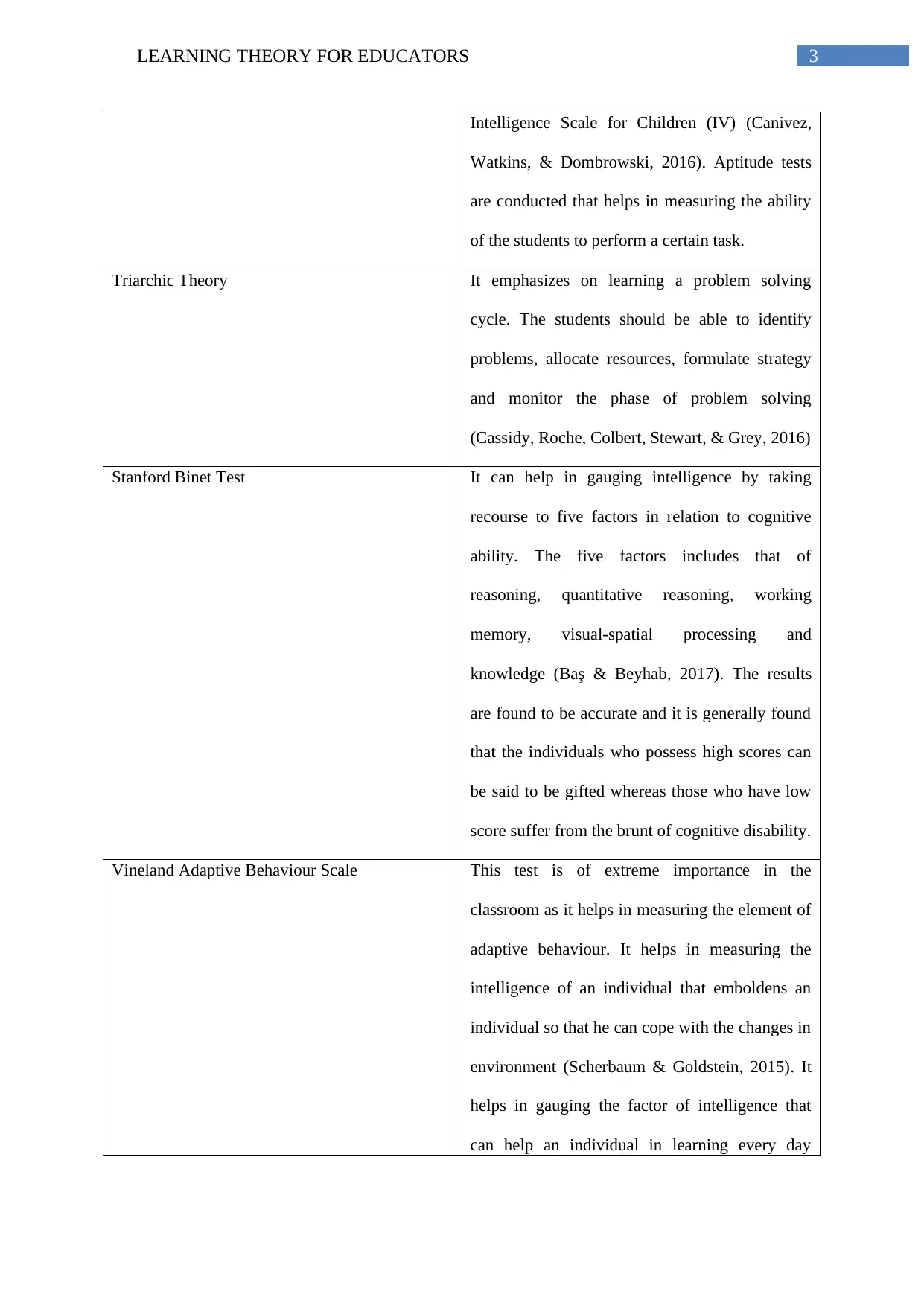
3LEARNING THEORY FOR EDUCATORS
Intelligence Scale for Children (IV) (Canivez,
Watkins, & Dombrowski, 2016). Aptitude tests
are conducted that helps in measuring the ability
of the students to perform a certain task.
Triarchic Theory It emphasizes on learning a problem solving
cycle. The students should be able to identify
problems, allocate resources, formulate strategy
and monitor the phase of problem solving
(Cassidy, Roche, Colbert, Stewart, & Grey, 2016)
Stanford Binet Test It can help in gauging intelligence by taking
recourse to five factors in relation to cognitive
ability. The five factors includes that of
reasoning, quantitative reasoning, working
memory, visual-spatial processing and
knowledge (Baş & Beyhab, 2017). The results
are found to be accurate and it is generally found
that the individuals who possess high scores can
be said to be gifted whereas those who have low
score suffer from the brunt of cognitive disability.
Vineland Adaptive Behaviour Scale This test is of extreme importance in the
classroom as it helps in measuring the element of
adaptive behaviour. It helps in measuring the
intelligence of an individual that emboldens an
individual so that he can cope with the changes in
environment (Scherbaum & Goldstein, 2015). It
helps in gauging the factor of intelligence that
can help an individual in learning every day
Intelligence Scale for Children (IV) (Canivez,
Watkins, & Dombrowski, 2016). Aptitude tests
are conducted that helps in measuring the ability
of the students to perform a certain task.
Triarchic Theory It emphasizes on learning a problem solving
cycle. The students should be able to identify
problems, allocate resources, formulate strategy
and monitor the phase of problem solving
(Cassidy, Roche, Colbert, Stewart, & Grey, 2016)
Stanford Binet Test It can help in gauging intelligence by taking
recourse to five factors in relation to cognitive
ability. The five factors includes that of
reasoning, quantitative reasoning, working
memory, visual-spatial processing and
knowledge (Baş & Beyhab, 2017). The results
are found to be accurate and it is generally found
that the individuals who possess high scores can
be said to be gifted whereas those who have low
score suffer from the brunt of cognitive disability.
Vineland Adaptive Behaviour Scale This test is of extreme importance in the
classroom as it helps in measuring the element of
adaptive behaviour. It helps in measuring the
intelligence of an individual that emboldens an
individual so that he can cope with the changes in
environment (Scherbaum & Goldstein, 2015). It
helps in gauging the factor of intelligence that
can help an individual in learning every day
Paraphrase This Document
Need a fresh take? Get an instant paraphrase of this document with our AI Paraphraser
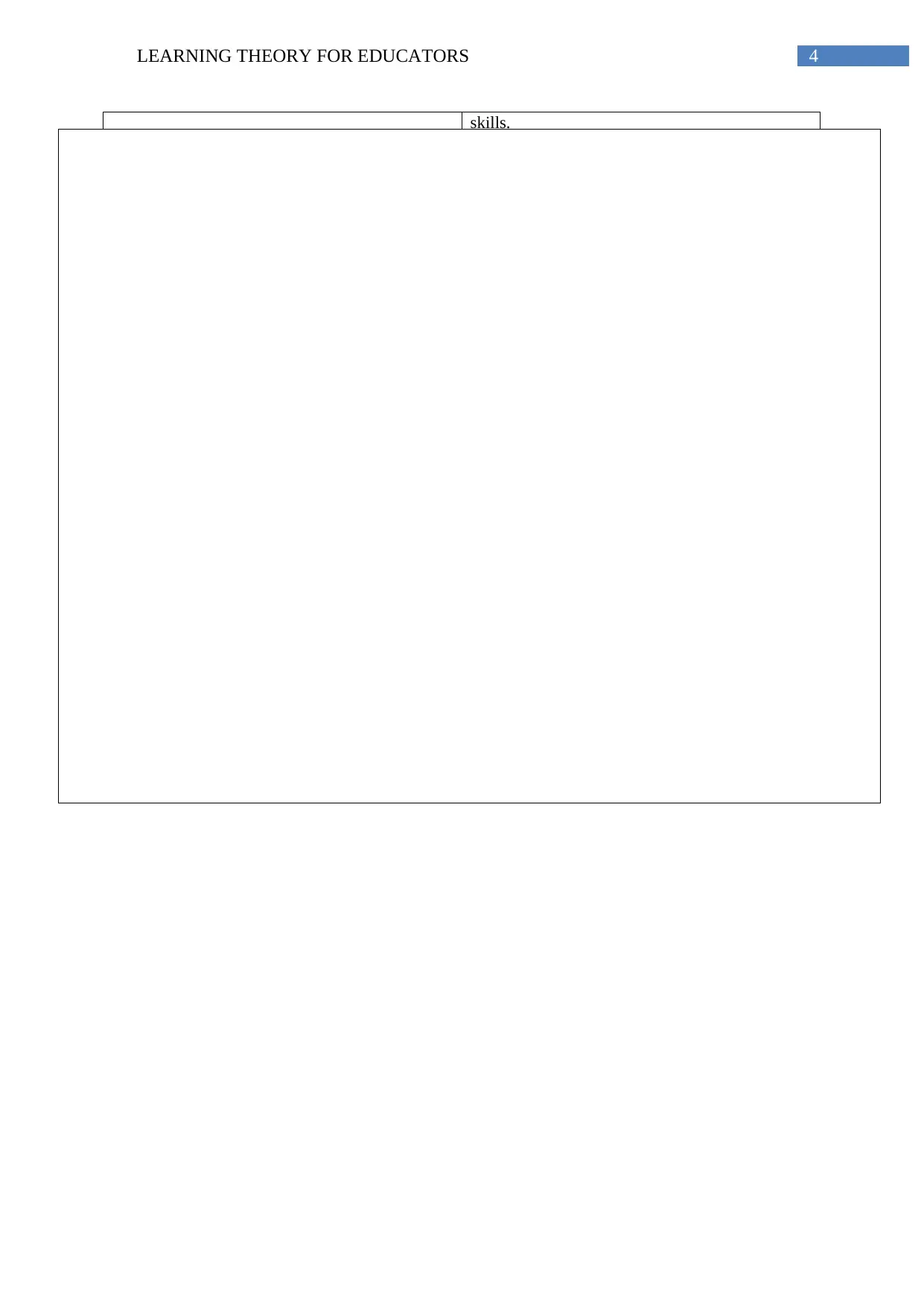
4LEARNING THEORY FOR EDUCATORS
Measuring Intelligence Problem Solving Triarchic Theory
Measures AbilityWechsler Scale
Taps into the distinct profile
Multiple Intelligence Approach
Identifies strength and weakness
Portfolio Assessment
Vineland Adaptive Behaviour Scale
Measures Adaptive Behaviour
Measures Cognitive ability
Stanford Binet Test
skills.
Measuring Intelligence Problem Solving Triarchic Theory
Measures AbilityWechsler Scale
Taps into the distinct profile
Multiple Intelligence Approach
Identifies strength and weakness
Portfolio Assessment
Vineland Adaptive Behaviour Scale
Measures Adaptive Behaviour
Measures Cognitive ability
Stanford Binet Test
skills.
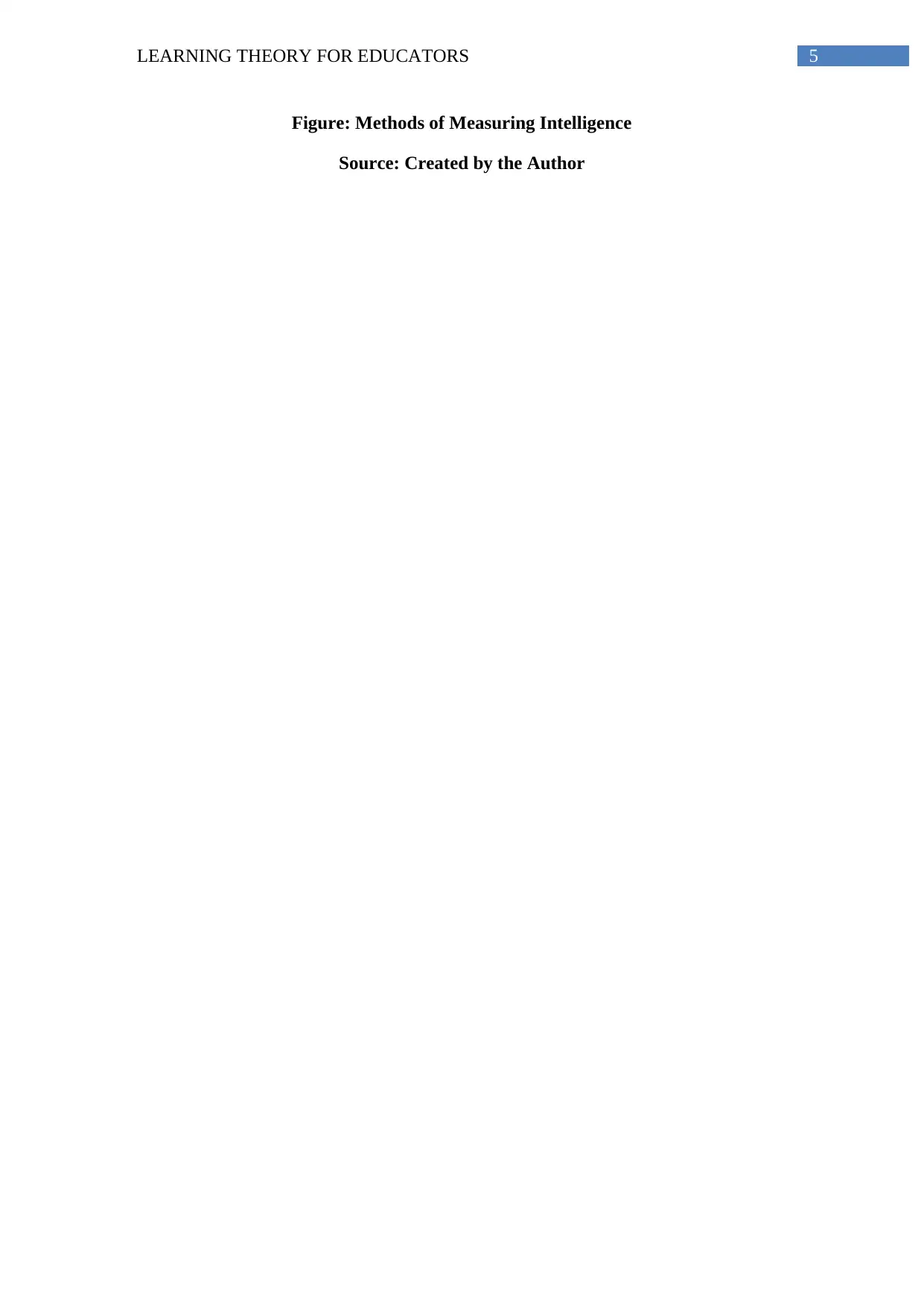
5LEARNING THEORY FOR EDUCATORS
Figure: Methods of Measuring Intelligence
Source: Created by the Author
Figure: Methods of Measuring Intelligence
Source: Created by the Author
⊘ This is a preview!⊘
Do you want full access?
Subscribe today to unlock all pages.

Trusted by 1+ million students worldwide
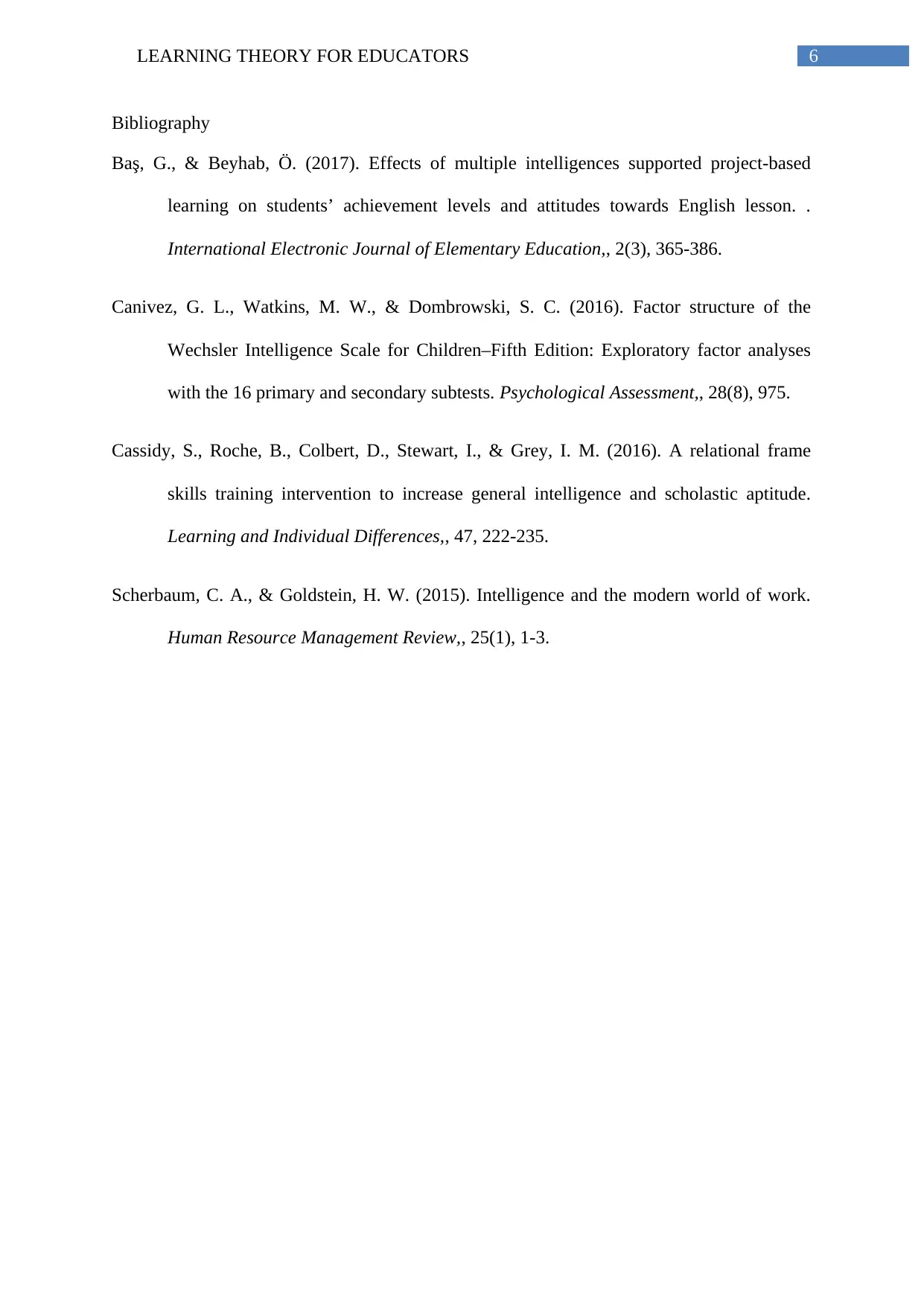
6LEARNING THEORY FOR EDUCATORS
Bibliography
Baş, G., & Beyhab, Ö. (2017). Effects of multiple intelligences supported project-based
learning on students’ achievement levels and attitudes towards English lesson. .
International Electronic Journal of Elementary Education,, 2(3), 365-386.
Canivez, G. L., Watkins, M. W., & Dombrowski, S. C. (2016). Factor structure of the
Wechsler Intelligence Scale for Children–Fifth Edition: Exploratory factor analyses
with the 16 primary and secondary subtests. Psychological Assessment,, 28(8), 975.
Cassidy, S., Roche, B., Colbert, D., Stewart, I., & Grey, I. M. (2016). A relational frame
skills training intervention to increase general intelligence and scholastic aptitude.
Learning and Individual Differences,, 47, 222-235.
Scherbaum, C. A., & Goldstein, H. W. (2015). Intelligence and the modern world of work.
Human Resource Management Review,, 25(1), 1-3.
Bibliography
Baş, G., & Beyhab, Ö. (2017). Effects of multiple intelligences supported project-based
learning on students’ achievement levels and attitudes towards English lesson. .
International Electronic Journal of Elementary Education,, 2(3), 365-386.
Canivez, G. L., Watkins, M. W., & Dombrowski, S. C. (2016). Factor structure of the
Wechsler Intelligence Scale for Children–Fifth Edition: Exploratory factor analyses
with the 16 primary and secondary subtests. Psychological Assessment,, 28(8), 975.
Cassidy, S., Roche, B., Colbert, D., Stewart, I., & Grey, I. M. (2016). A relational frame
skills training intervention to increase general intelligence and scholastic aptitude.
Learning and Individual Differences,, 47, 222-235.
Scherbaum, C. A., & Goldstein, H. W. (2015). Intelligence and the modern world of work.
Human Resource Management Review,, 25(1), 1-3.
Paraphrase This Document
Need a fresh take? Get an instant paraphrase of this document with our AI Paraphraser
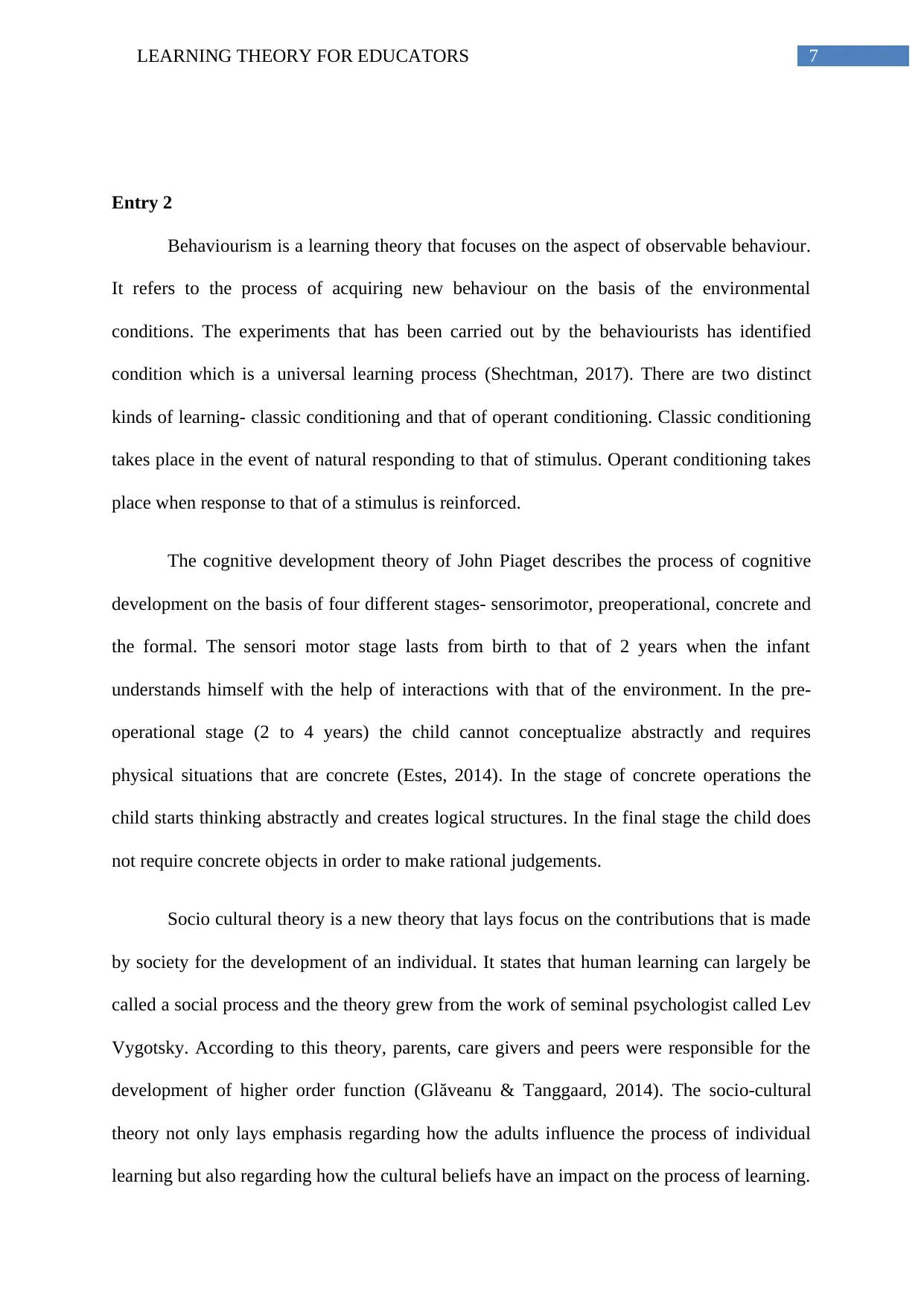
7LEARNING THEORY FOR EDUCATORS
Entry 2
Behaviourism is a learning theory that focuses on the aspect of observable behaviour.
It refers to the process of acquiring new behaviour on the basis of the environmental
conditions. The experiments that has been carried out by the behaviourists has identified
condition which is a universal learning process (Shechtman, 2017). There are two distinct
kinds of learning- classic conditioning and that of operant conditioning. Classic conditioning
takes place in the event of natural responding to that of stimulus. Operant conditioning takes
place when response to that of a stimulus is reinforced.
The cognitive development theory of John Piaget describes the process of cognitive
development on the basis of four different stages- sensorimotor, preoperational, concrete and
the formal. The sensori motor stage lasts from birth to that of 2 years when the infant
understands himself with the help of interactions with that of the environment. In the pre-
operational stage (2 to 4 years) the child cannot conceptualize abstractly and requires
physical situations that are concrete (Estes, 2014). In the stage of concrete operations the
child starts thinking abstractly and creates logical structures. In the final stage the child does
not require concrete objects in order to make rational judgements.
Socio cultural theory is a new theory that lays focus on the contributions that is made
by society for the development of an individual. It states that human learning can largely be
called a social process and the theory grew from the work of seminal psychologist called Lev
Vygotsky. According to this theory, parents, care givers and peers were responsible for the
development of higher order function (Glăveanu & Tanggaard, 2014). The socio-cultural
theory not only lays emphasis regarding how the adults influence the process of individual
learning but also regarding how the cultural beliefs have an impact on the process of learning.
Entry 2
Behaviourism is a learning theory that focuses on the aspect of observable behaviour.
It refers to the process of acquiring new behaviour on the basis of the environmental
conditions. The experiments that has been carried out by the behaviourists has identified
condition which is a universal learning process (Shechtman, 2017). There are two distinct
kinds of learning- classic conditioning and that of operant conditioning. Classic conditioning
takes place in the event of natural responding to that of stimulus. Operant conditioning takes
place when response to that of a stimulus is reinforced.
The cognitive development theory of John Piaget describes the process of cognitive
development on the basis of four different stages- sensorimotor, preoperational, concrete and
the formal. The sensori motor stage lasts from birth to that of 2 years when the infant
understands himself with the help of interactions with that of the environment. In the pre-
operational stage (2 to 4 years) the child cannot conceptualize abstractly and requires
physical situations that are concrete (Estes, 2014). In the stage of concrete operations the
child starts thinking abstractly and creates logical structures. In the final stage the child does
not require concrete objects in order to make rational judgements.
Socio cultural theory is a new theory that lays focus on the contributions that is made
by society for the development of an individual. It states that human learning can largely be
called a social process and the theory grew from the work of seminal psychologist called Lev
Vygotsky. According to this theory, parents, care givers and peers were responsible for the
development of higher order function (Glăveanu & Tanggaard, 2014). The socio-cultural
theory not only lays emphasis regarding how the adults influence the process of individual
learning but also regarding how the cultural beliefs have an impact on the process of learning.
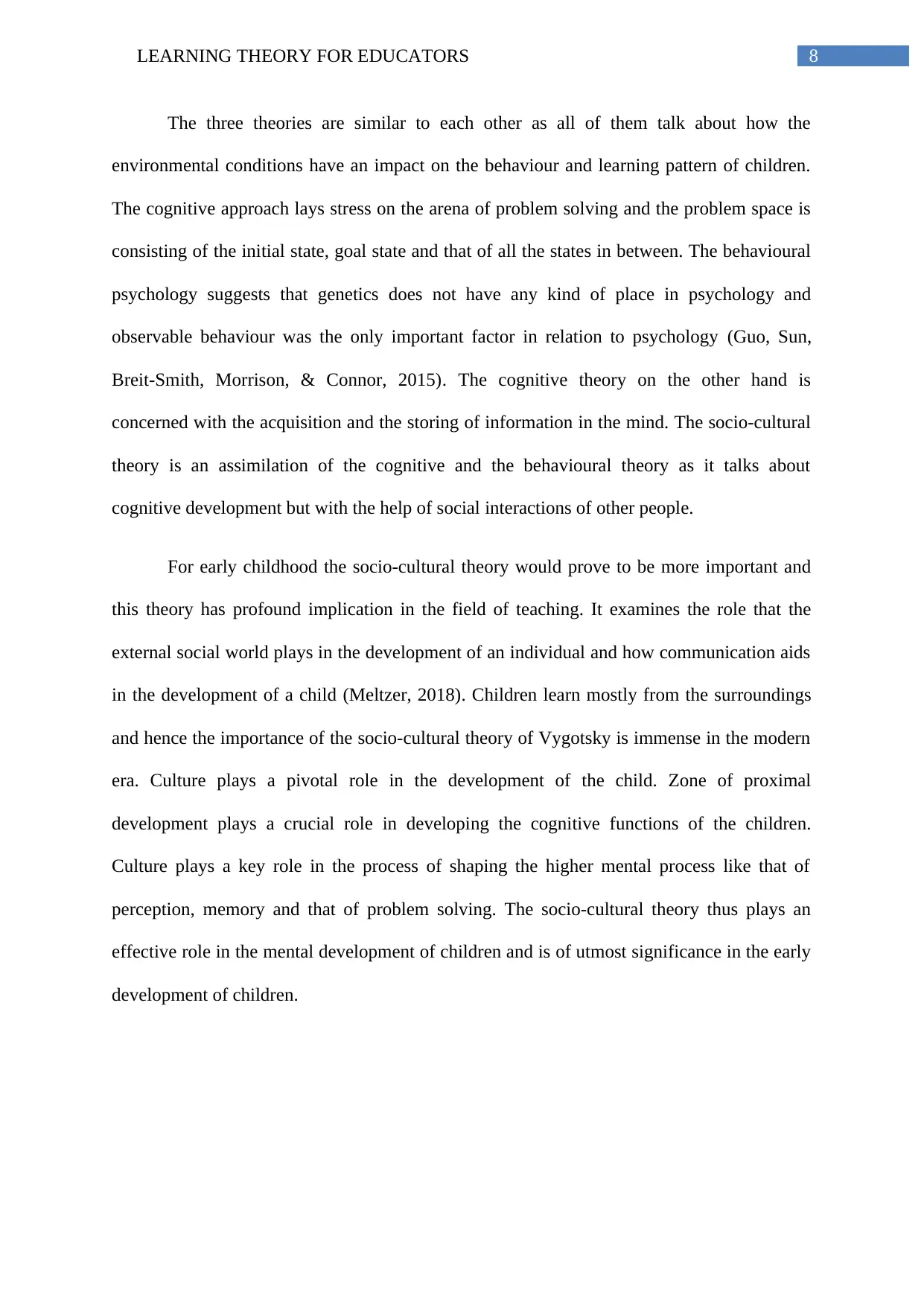
8LEARNING THEORY FOR EDUCATORS
The three theories are similar to each other as all of them talk about how the
environmental conditions have an impact on the behaviour and learning pattern of children.
The cognitive approach lays stress on the arena of problem solving and the problem space is
consisting of the initial state, goal state and that of all the states in between. The behavioural
psychology suggests that genetics does not have any kind of place in psychology and
observable behaviour was the only important factor in relation to psychology (Guo, Sun,
Breit-Smith, Morrison, & Connor, 2015). The cognitive theory on the other hand is
concerned with the acquisition and the storing of information in the mind. The socio-cultural
theory is an assimilation of the cognitive and the behavioural theory as it talks about
cognitive development but with the help of social interactions of other people.
For early childhood the socio-cultural theory would prove to be more important and
this theory has profound implication in the field of teaching. It examines the role that the
external social world plays in the development of an individual and how communication aids
in the development of a child (Meltzer, 2018). Children learn mostly from the surroundings
and hence the importance of the socio-cultural theory of Vygotsky is immense in the modern
era. Culture plays a pivotal role in the development of the child. Zone of proximal
development plays a crucial role in developing the cognitive functions of the children.
Culture plays a key role in the process of shaping the higher mental process like that of
perception, memory and that of problem solving. The socio-cultural theory thus plays an
effective role in the mental development of children and is of utmost significance in the early
development of children.
The three theories are similar to each other as all of them talk about how the
environmental conditions have an impact on the behaviour and learning pattern of children.
The cognitive approach lays stress on the arena of problem solving and the problem space is
consisting of the initial state, goal state and that of all the states in between. The behavioural
psychology suggests that genetics does not have any kind of place in psychology and
observable behaviour was the only important factor in relation to psychology (Guo, Sun,
Breit-Smith, Morrison, & Connor, 2015). The cognitive theory on the other hand is
concerned with the acquisition and the storing of information in the mind. The socio-cultural
theory is an assimilation of the cognitive and the behavioural theory as it talks about
cognitive development but with the help of social interactions of other people.
For early childhood the socio-cultural theory would prove to be more important and
this theory has profound implication in the field of teaching. It examines the role that the
external social world plays in the development of an individual and how communication aids
in the development of a child (Meltzer, 2018). Children learn mostly from the surroundings
and hence the importance of the socio-cultural theory of Vygotsky is immense in the modern
era. Culture plays a pivotal role in the development of the child. Zone of proximal
development plays a crucial role in developing the cognitive functions of the children.
Culture plays a key role in the process of shaping the higher mental process like that of
perception, memory and that of problem solving. The socio-cultural theory thus plays an
effective role in the mental development of children and is of utmost significance in the early
development of children.
⊘ This is a preview!⊘
Do you want full access?
Subscribe today to unlock all pages.

Trusted by 1+ million students worldwide
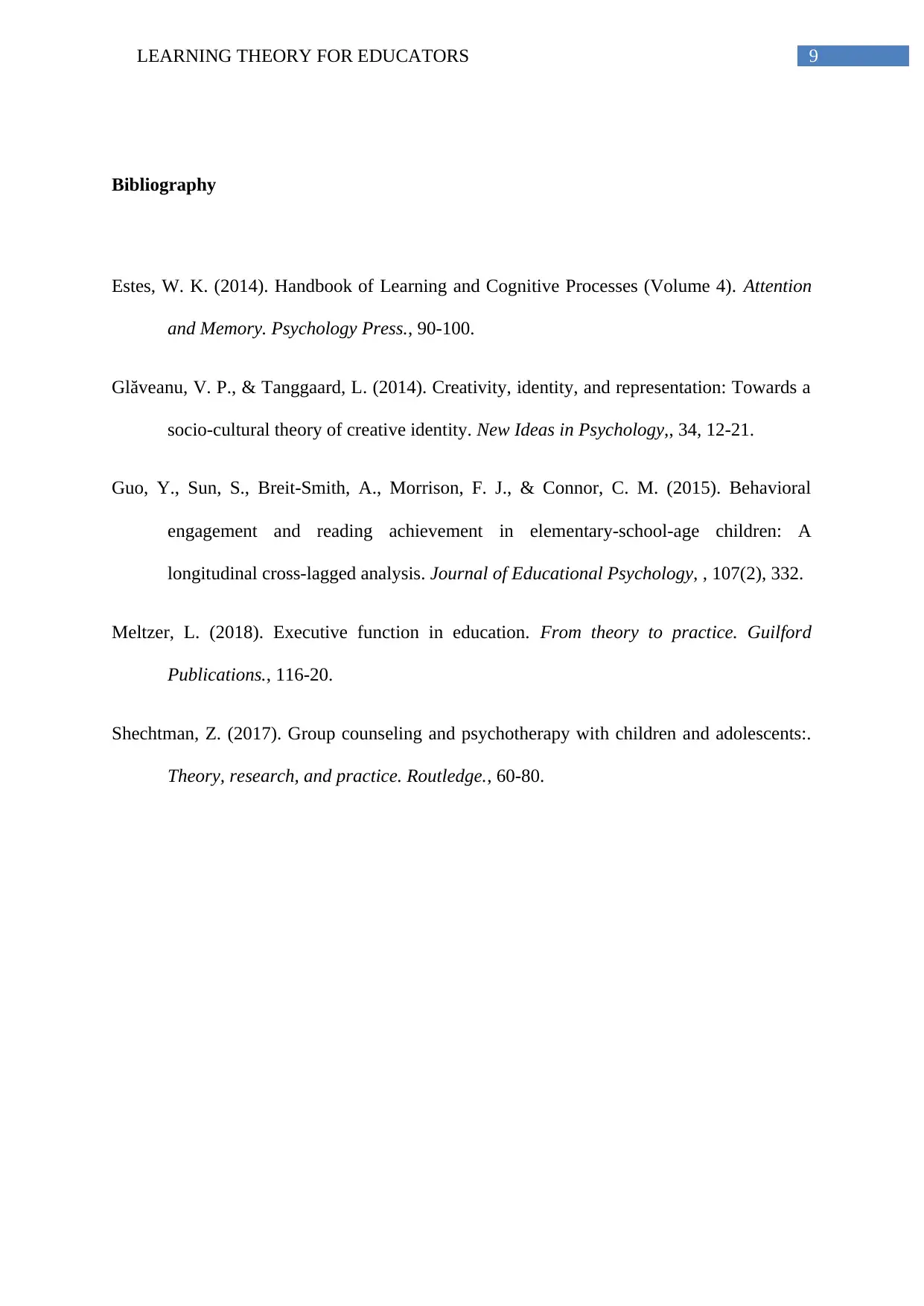
9LEARNING THEORY FOR EDUCATORS
Bibliography
Estes, W. K. (2014). Handbook of Learning and Cognitive Processes (Volume 4). Attention
and Memory. Psychology Press., 90-100.
Glăveanu, V. P., & Tanggaard, L. (2014). Creativity, identity, and representation: Towards a
socio-cultural theory of creative identity. New Ideas in Psychology,, 34, 12-21.
Guo, Y., Sun, S., Breit-Smith, A., Morrison, F. J., & Connor, C. M. (2015). Behavioral
engagement and reading achievement in elementary-school-age children: A
longitudinal cross-lagged analysis. Journal of Educational Psychology, , 107(2), 332.
Meltzer, L. (2018). Executive function in education. From theory to practice. Guilford
Publications., 116-20.
Shechtman, Z. (2017). Group counseling and psychotherapy with children and adolescents:.
Theory, research, and practice. Routledge., 60-80.
Bibliography
Estes, W. K. (2014). Handbook of Learning and Cognitive Processes (Volume 4). Attention
and Memory. Psychology Press., 90-100.
Glăveanu, V. P., & Tanggaard, L. (2014). Creativity, identity, and representation: Towards a
socio-cultural theory of creative identity. New Ideas in Psychology,, 34, 12-21.
Guo, Y., Sun, S., Breit-Smith, A., Morrison, F. J., & Connor, C. M. (2015). Behavioral
engagement and reading achievement in elementary-school-age children: A
longitudinal cross-lagged analysis. Journal of Educational Psychology, , 107(2), 332.
Meltzer, L. (2018). Executive function in education. From theory to practice. Guilford
Publications., 116-20.
Shechtman, Z. (2017). Group counseling and psychotherapy with children and adolescents:.
Theory, research, and practice. Routledge., 60-80.
1 out of 10
Related Documents
Your All-in-One AI-Powered Toolkit for Academic Success.
+13062052269
info@desklib.com
Available 24*7 on WhatsApp / Email
![[object Object]](/_next/static/media/star-bottom.7253800d.svg)
Unlock your academic potential
Copyright © 2020–2025 A2Z Services. All Rights Reserved. Developed and managed by ZUCOL.





